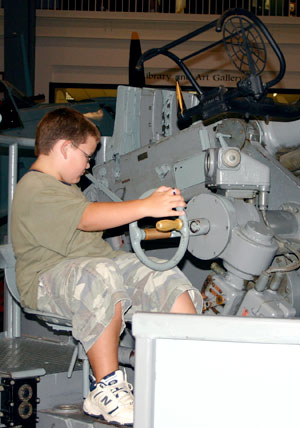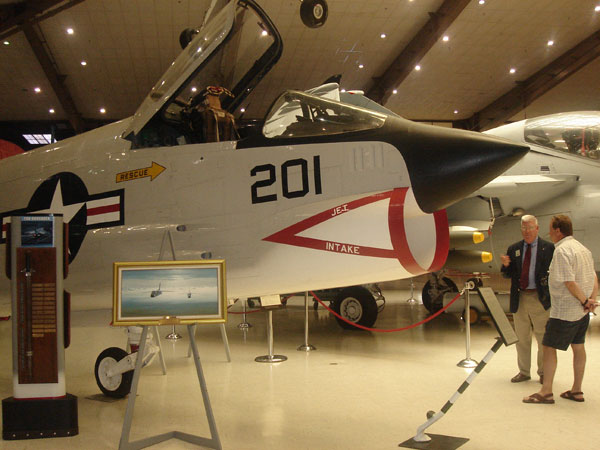PENSACOLA, FLA. - In his younger years, Denis “Deej” Kiely was every bit a Top Gun fighter pilot as the one Tom Cruise portrayed in the iconic film.
Now, the grandfatherly Kiely plays a different role — that of tour guide around the fascinating Naval Aviation Museum at the Naval Air Station located in this northern Florida city.
The museum is a storehouse of American military history and is jammed with aircraft dating back to the earliest ones used by U.S. forces in combat.
Kiely, a retired Marine Colonel and noew a museum volunteer, keeps visitors spellbound with his knowledge of the aircraft and ships on display in the museum and with his passion for all things aeronautic.
“That’s the type of plane I flew in Vietnam,” says the distinguished looking Kiely as he points to an F84 Crusader, one of the sleek fighter jets he commanded during his Marine career.
“People always ask how many missions I flew but honestly, I can’t remember. Maybe 250 — you lose count after a while,” says the man who piloted a variety of aircraft during his career.
There are between 85-100 aircraft on display at any one time in the 291,000-square-foot museum that opened in 1962.
As you enter the massive facility that has had several wings added since it first took flight, Kiely introduces me to five bronze aviators stationed near the front entrance. The five represent different periods in U.S. Naval aviation history, from World War I to the first Desert Storm conflict in 1991.
“We are very proud of this statue,” says Kiely who, along with many of the museum’s other 450 volunteers worked hard to ensure the bronze memorial became a reality. “It was erected in 1994 and so many people have told us how proud they are when they stand in front of it.”
It’s just one of the many fascinating displays at the museum, but not the most fascinating.
That honours goes to the massive, seven-storey Canadian inspired Imax movie theatre that takes visitors on a magical cinematic journey through the skies — tracing the origins of flight and documenting the skills required by naval pilots before they can earn their wings as a member of the famed Blue Angels — the American version of Canada’s stunt flying team, the Snowbirds.
Kiely beams when he talks about the film and the theatre, which can hold up to 525 people.


Left: Young aviators get a chance to play on the relics of war. Right: Denis Kiely tells a visitor about the planes he flew in Vietnam.
“We’ve had many premiers here, including Everest,” says the former Marine. “Every person who comes out of the theatre after watching our film has only good things to say about it.”
Titled The Magic of Flight, the film is a thrill ride that informs visitors about how early aviators, including the Wright brothers, got their primitive flight plans off the ground by watching and learning from birds. Then visitors are projected through time and into the cockpit of the dark blue planes flown by the Blue Angels, who train hundreds of hours at nearby Sherman Field to they can thrill spectators at air shows around the world. It takes true grit to become a member of the stunt team, who are great ambassadors for the U.S. Navy.
Through the magic of Hollywood, the 40-minute film also allows museum visitors to feel the thrill of landing a fighter jet on a moving aircraft carrier.
“It cost about $100,000 (U.S.) a minute to build the theatre — I’ll let you do the math,” laughs Kiely, who said the debt incurred for the theatre and film were wiped out by the Boeing corporation.
The Imax film has become a favourite with the over two million people who visit the facility each year and is a great introduction to the facility.
Back on the museum floor, Kiely tells us to qualify to be displayed here, exhibits must have a U.S. Navy history — the Marine Corps are a branch of the Navy.
That includes some World War I biplanes that the U.S. had to buy from France and England in order to launch their naval air services in 1911. One of them has a giant Snoopy dog sitting in the pilots seat.
“The budget for the Navy back then was just $25,000 (U.S.),” Kiely tells us. “Now, the U.S. Navy’s annual budget is approaching $3 trillion (U.S.).”
Sitting among the many powerful jets in the museum is a lone single-seater Cessna aircraft that the U.S. Navy used for recognisance missions in Vietnam. The fragile-looking little aircraft holds special prominence here.
“A Vietnamese man named Bung Ly squeezed his wife and son into that small plane as Saigon (now known as Ho Chi Min City) was about to fall to the communists in the final days of the Vietnam War on April 30, 1975,” an emotional Kiely began.
“He flew it out to sea and attempted to land it on one of our (U.S.) carriers (the USS Midway), something he had never done before. The Midway’s captain ordered all the helicopters that had arrived earlier thrown overboard to give the man more room to land.”
A photograph on display next to the Cessna shows jubilant naval personnel jumping into the air as the man successfully brought the plane to a stop on the Midway’s deck.
“It was one of the most thrilling moments any of us ever witnessed,” says Kiely.
As we pass an old fighter jet known as a Sabre, Kiely tells us “the Canadian version of this plane was the best. The Canadian Air Force stripped out the original engines and replaced them with more powerful Rolls Royce engines.”
The section of the museum devoted to aircraft and ships employed during World War II is the most interesting. The aircraft on display there all distinguished themselves during the war and include a fighter used by the Japanese against American ships.
A wooden deck and the conning tower from an old World War II aircraft carrier also captivates visitors. The conning tower displays the many “kills” recorded by aircraft launched from the carrier USS Cabot against Japanese ships and aircraft.
Kiely again peeks our curiosity by telling us: “There’s another interesting story connected with those markings.
“A few years ago a visitor came into the museum and told us his father had shown him similar markings in photos he had from the war. We asked the man to have his father contact us and it turned out the man served on the Cabot and actually had painted the markings on the ship during the war.
“We invited him down, wiped clean the markings we had painted from records and asked him to reproduce his original markings. His son’s visit was a great coincidence and the museum really benefited from it,” says Kiely.
The first aircraft carrier ever used by the U.S. actually came into service in 1922, according to our guide.
Another recent addition to the museum is the Blue Angels Atrium, where old jets used by the formation team hang from the rafters.
Because this is an active base, visitors get to see many uniformed sailors and Marines walking about the place, and all seem to be in awe of the archaic equipment once used by their predecessors,
“During WWII, U.S. factories were producing up to 75 planes a day,” reports Kiely. “That meant someone had to transport the pilots to the factories to pick them up so they could deliver them to the Navy. That job was performed by women flyers and I’m delighted to say they have finally been recognized for their contributions.”
It’s also exciting to touch the delicate skins of the old planes, which were made of fabric.
Potential young flyers get a chance to sit in open cockpits during their visit to the museum and a new 246,000 expansion being planned will include more educational exhibits and a flight academy, according to Kiely.
It takes about two hours to tour the museum. It may be the best two hours you spend in Florida.
Information
-The Imax theatre has slots for the physically challenged.
- Because the museum is on an active military base, visitors need to show photo ID before being allowed into the museum.
- Most of the 450 volunteers at the museum have served in the U.S. Navy, Coast Guard or Marines.
- The museum is open every day of the year from 9 a.m. to 5 p.m. — except U.S. Thanksgiving, Christmas and New Year’s Day.
- Admission is free.
- The naval museum os the largest and most visited in Florida.
- For information on the museum, call toll free 1-800-327-5002 or go to www.naval-air.org or www.visitflorida.com